Intel Core i9-14900KS Review: The Swan Song of Raptor Lake With A Super Fast 6.2 GHz Turbo
by Gavin Bonshor on May 10, 2024 10:30 AM ESTCPU Benchmark Performance: Power, Productivity and Web
Our previous sets of ‘office’ benchmarks have often been a mix of science and synthetics, so this time, we wanted to keep our office and productivity section purely based on real-world performance. We've also incorporated our power testing into this section.
The biggest update to our Office-focused tests for 2024 and beyond includes UL's Procyon software, which is the successor to PCMark. Procyon benchmarks office performance using Microsoft Office applications and Adobe Premier Pro's video editing capabilities.
We are using DDR5 memory on the Core i9-14900KS, as well as the other Intel 14th Gen Core series processors, including the Core i9-14900K, the Core i7-14700K, Core i5-14600K, and Intel's 13th Gen at the relative JEDEC settings. The same methodology is used for the AMD Ryzen 7000 series and Intel's 12th Gen (Alder Lake) processors. Below are the settings we have used for each platform:
- DDR5-5600B CL46 - Intel 14th & 13th Gen
- DDR5-5200 CL44 - Ryzen 7000
- DDR5-4800 (B) CL40 - Intel 12th Gen
Power
The nature of reporting processor power consumption has become, in part, a bit of a nightmare. Historically the peak power consumption of a processor, as purchased, is given by its Thermal Design Power (TDP, or PL1). For many markets, such as embedded processors, that value of TDP still signifies the peak power consumption. For the processors we test at AnandTech, either desktop, notebook, or enterprise, this is not always the case.
Modern high-performance processors implement a feature called Turbo. This allows, usually for a limited time, a processor to go beyond its rated frequency. Exactly how far the processor goes depends on a few factors, such as the Turbo Power Limit (PL2), whether the peak frequency is hard coded, the thermals, and the power delivery. Turbo can sometimes be very aggressive, allowing power values 2.5x above the rated TDP.
AMD and Intel have different definitions for TDP that are, broadly speaking, applied the same. The difference comes from turbo modes, turbo limits, turbo budgets, and how the processors manage that power balance. These topics are 10000-12000 word articles in their own right, and we’ve got a few articles worth reading on the topic.
- Why Intel Processors Draw More Power Than Expected: TDP and Turbo Explained
- Talking TDP, Turbo and Overclocking: An Interview with Intel Fellow Guy Therien
- Reaching for Turbo: Aligning Perception with AMD’s Frequency Metrics
- Intel’s TDP Shenanigans Hurts Everyone
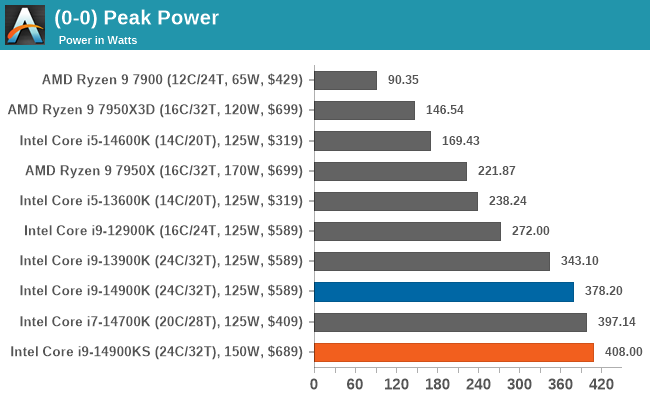
Looking at power consumption, the Core i9-14900KS, as expected, pulls a lot of power, 408 W, to be exact, in our peak power test. In the grand scheme of things, using our ASRock Z790 Taichi Cararra at default (motherboard default, not Intel Default), it pulls just under 8% more than the regular Core i9-14900K. Compared to AMD's Ryzen 9 7000 series chips, the Core i9-14900KS is pulling over double the power of the Ryzen 9 7950X, which is simply crazy.
When using a heavy load such as yCruncher, the Intel Core i9-14900KS is significantly more powerful than the non-special edition Core i9-14900 K. In the multi-threaded benchmark, the Core i9-14900KS consistently spikes above 400 W. In contrast, the Core i9-14900K doesn't go beyond 360 W. Given how similar both chips are in performance, the additional power used and the additional heat generated certainly don't equate to the same jump in performance, at least not when looking at it from percentiles.
Moving down to gaming, we can see that the Core i9-14900KS uses much less power than when the workload is intensely dependent on the CPU. In F1 2023 at 1080p High settings, the Core i9-14900KS does use more power than the Core i9-14900K, by around 10 to 12 W, although the Core i9-14900K did spike just as high during the most intensive scene. This means the frequencies are more consistent when gaming as they do not hit the thermal limits, at least not with the 360mm AIO cooler we use from MSI.
Overall, the true nature of the Intel Core i9-14900KS with the 6.2 GHz maximum turbo ultimately uses more CPU VCore, up to 1.44 V, as we monitored, which is frankly too high for any Raptor Lake chip to be operating at. The thermal limits become a nuisance, although Intel's design means that they can hit the TJ Maxx (maximum temperature) and still perform well due to the utilization of Intel's Thermal Velocity Boost. It is still difficult to praise any desktop processor that uses 400 W at full load, and as with other KS SKUs we have tested, we're experiencing much the same issues in the way of power and thermal usage.
Productivity and Web
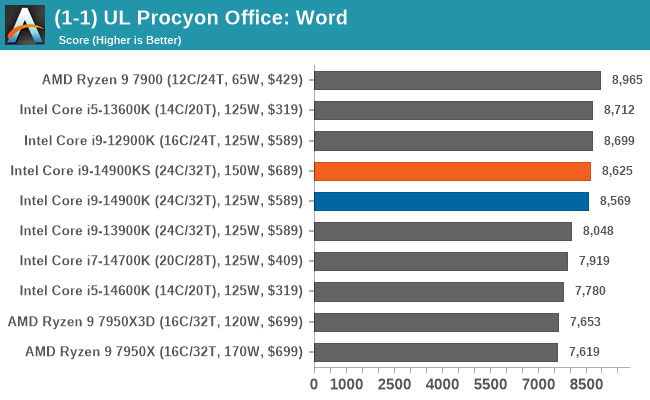
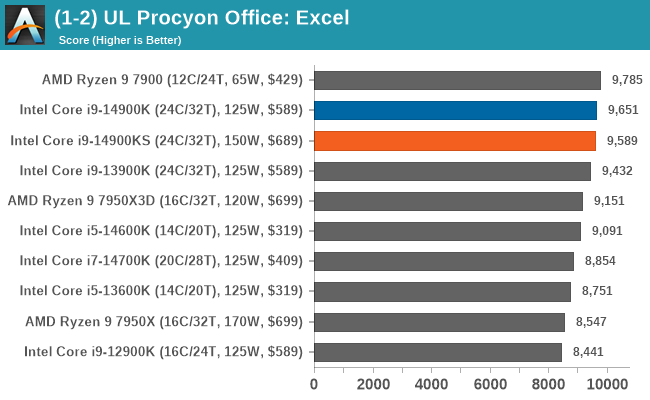
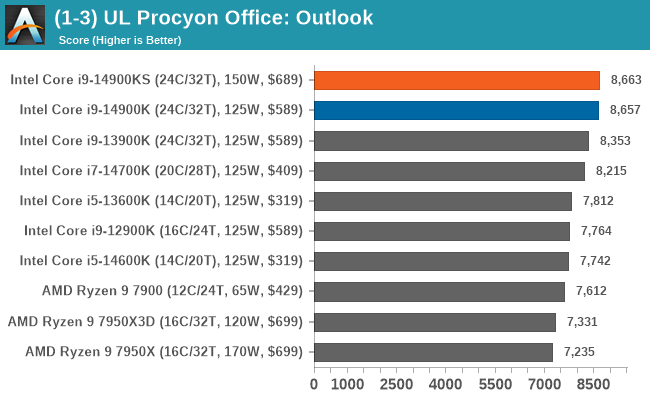
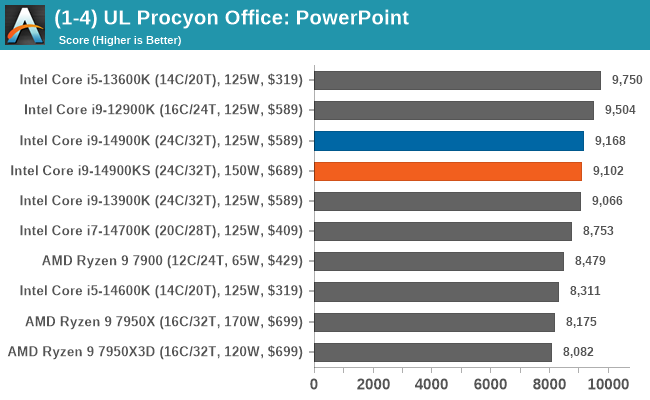
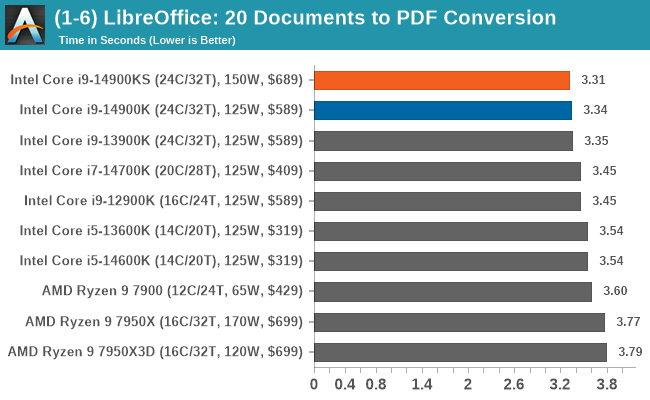
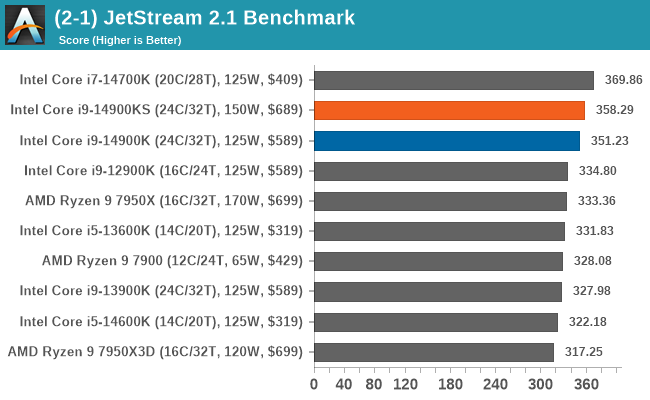
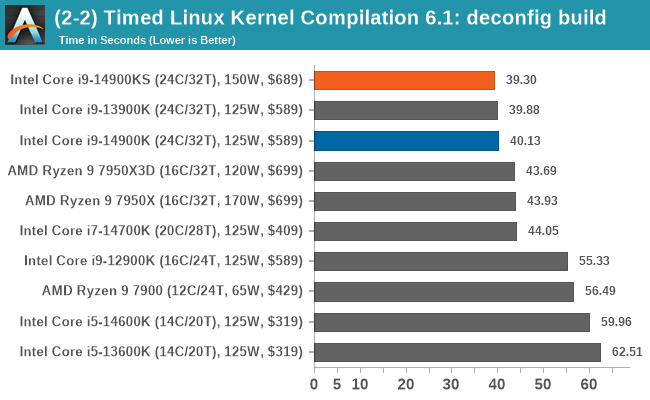
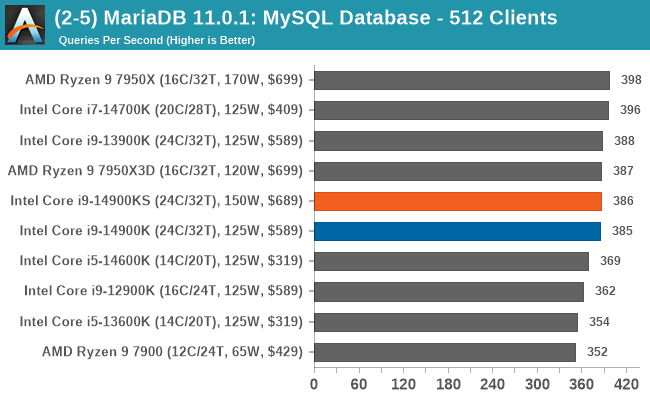
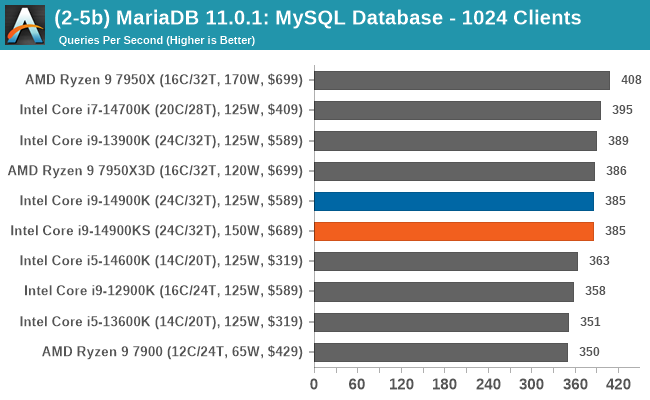
Our productivity and web-based section consistently see the Core i9-14900KS trade blows with the Core i9-14900K. In the timed tests such as LibreOffice and the Linux Kernel Compilation benchmark, the additional frequency helps marginally, but it doesn't change things much. At least not from a real-world performance standpoint in this area.



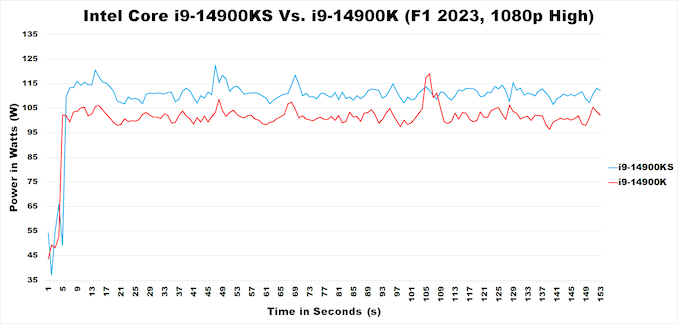








54 Comments
View All Comments
PeachNCream - Sunday, May 12, 2024 - link
Reasonably, yes readers shouldn't be concerned with AT funding and staffing problems, but I think it's out of an abundance of kindness that we try our best to overlook the inaccuracies, incompleteness, and typos that currently plagues content here on an on-going basis in the hopes of being encouraging for the future health of the site. Assuming it gets a little time and effort from both employees and leadership, AT can once again become a useful site that does more than just repost company press releases and add grammatical errors during ill-informed fluff commentary. ReplyIketh - Monday, May 13, 2024 - link
Is there a donate/patreon link? Gotta get with the times. Get funding for complete reviews instead of releasing data which isn't even recommended by Intel. I know this site can't make enough money to keep people around even with all these ads. If your base readership gave $5 per year, I bet you could afford some full-time staff. Replygoatfajitas - Sunday, May 12, 2024 - link
It went downhill even before Anand left. At some point he sort of "checked out". ReplyGeoffreyA - Monday, May 13, 2024 - link
He caught the Apple bug... ReplyPeachNCream - Tuesday, May 14, 2024 - link
Didn't Apple eventually turn Anand into an employee? If the half-eaten fruit company bribed me with a lorry load of money, I'd have departed as well and at least played lip service to their overpriced popularity contest products. Running this site has to be more than a bit draining for someone that might have cared. ReplyAndrewJacksonZA - Saturday, May 11, 2024 - link
Thanks Gavin. The Intel BIOS issue is something that I've been wondering if the press would re-test CPUs or not for. Replymode_13h - Sunday, May 12, 2024 - link
> Don't worry; I will be testing Intel Default settings, too.Thank you. I'm looking forward to it. Reply
Oxford Guy - Monday, May 20, 2024 - link
As we all are... ... ... Replyshabby - Monday, May 13, 2024 - link
Just use an air cooler, 400w power usage problem solved. Replypowerarmour - Sunday, May 12, 2024 - link
Absolutely, considering comments were removed on the last article this smells of bias otherwise. Reply